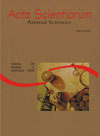<b>Crescimento, produtividade, caracterização e composição química da aveia branca</b> - DOI: 10.4025/actascianimsci.v29i1.241
Resumo
Foi conduzido um experimento na Escola Superior de Agricultura Luiz de Queiroz, Piracicaba, Estado de São Paulo, para avaliar o crescimento, produtividade, características morfológicas e fenológicas e a composição química da aveia branca (Avena sativa L. cv. UPF 7). Os tratamentos constaram de épocas de cortes a cada 14 dias, dispostos ao acaso, com três repetições. O acúmulo de matéria seca (MS) apresentou efeito quadrático, atingindo 12.240 kg ha-1 na maturação. O acúmulo máximo de proteína bruta (PB) ocorreu 98 dias após a emergência (DAE) (818 kg ha-1), sendo que o teor de PB e a digestibilidade in vitro da MS (DIVMS) decresceram de 24,9% e 82,2% aos 14 DAE para 4,9% e 36,8% na maturação, respectivamente. Aos 70 DAE a DIVMS foi de 68%, com rendimento de 3.693 kg ha-1 de MS, altura de plantas de 63 cm e teores de 18,9% de PB, 0,28% de Ca e 0,37% de P. A disponibilidade ótima de forragem para alimentação animal (1.500 kg MS ha-1) foi estimada para 37 DAE, com as plantas apresentando altura de 33 cm, 21,4% de PB, 0,4% de P, 0,27% de Ca e uma DIVMS de 75,5%. A época indicada para utilização da aveia, considerando a disponibilidade de forragem e a DIVMS está entre 37 e 70 DAE.Downloads
DECLARAÇÃO DE ORIGINALIDADE E DIREITOS AUTORAIS
Declaro que o presente artigo é original, não tendo sido submetido à publicação em qualquer outro periódico nacional ou internacional, quer seja em parte ou em sua totalidade.
Os direitos autorais pertencem exclusivamente aos autores. Os direitos de licenciamento utilizados pelo periódico é a licença Creative Commons Attribution 4.0 (CC BY 4.0): são permitidos o compartilhamento (cópia e distribuição do material em qualqer meio ou formato) e adaptação (remix, transformação e criação de material a partir do conteúdo assim licenciado para quaisquer fins, inclusive comerciais.
Recomenda-se a leitura desse link para maiores informações sobre o tema: fornecimento de créditos e referências de forma correta, entre outros detalhes cruciais para uso adequado do material licenciado.








































